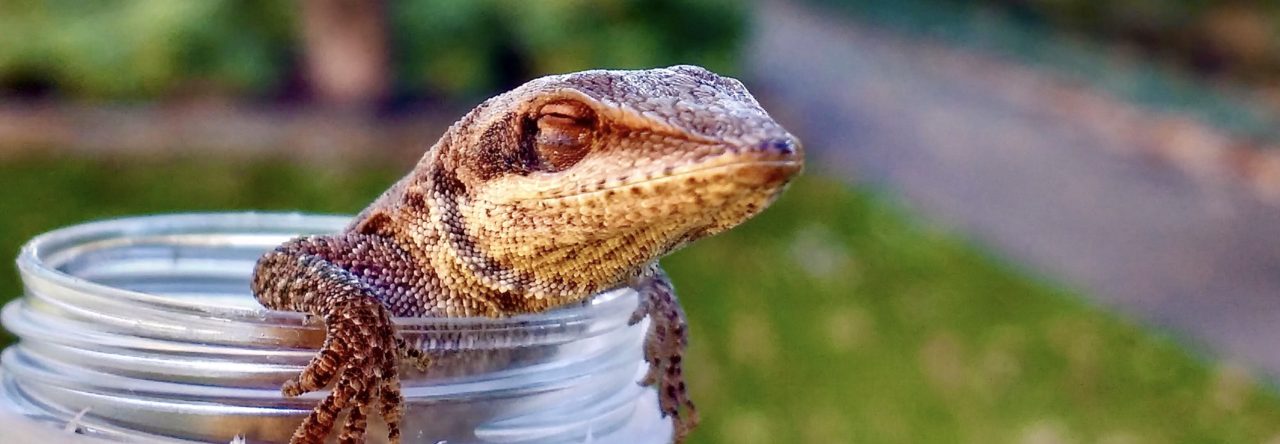
Anolis maynardi–doing just fine alongside brown anoles on Little Cayman
Two days ago, Ambika Kamath posted an entry in which she observed that the green anoles in her study site in Gainesville are doing just fine, they’re just high up in the trees and harder to spot than the abundant browns. She concluded that, contrary to what many think, brown anoles are not threatening greens in Florida with extinction.
I’d like to add to Ambika’s conclusion by pointing out how browns and greens interact throughout the natural range. Both species evolved in Cuba. There members of the sagrei group coexist widely with carolinensis’s relatives. Where they co-occur, brown anoles are very abundant and are found on the ground and low in vegetation. Greens, primarily A. allisoni and A. porcatus are seemingly less abundant (population estimates are not available) and they occur on tree trunks on up into the canopy.
This mostly peaceful coexistence is repeated in other places the two species co-occur. In the Bahamas, it’s A. smaragdinus and A. sagrei, on Little Cayman, it’s A. maynardi and A. sagrei. In both cases, sagrei is apparently much more abundant, and the two species occupy different parts of the habitat.
Some time ago (possibly several million years, according to genetic data), green anoles colonized Florida from Cuba. In the absence of browns, the greens took the arboreal to increase their habitat use, a phenomenon termed “ecological release.” Then the browns arrived, thanks to us. They have moved into their ancestral niche and the ancient order has been restored. Greens have moved back up in the trees and, yes, their populations are probably now smaller, because some of the resources they were using are now taken by browns. But they’re not going extinct. Greens and browns stably coexist throughout their range. That’s what they’ll do in Florida, too, as long as all the trees aren’t cut down for shopping malls and parking lots.
- Evolution in Real Time on Lizard Island - March 23, 2025
- Spider Snags Adult Anolis osa - March 22, 2025
- An Homage to the Green Anoles of New Orleans - March 21, 2025


Skip Lazell
I think you mean “took the more terrestrial….” Note too that the carolinensis representatives have speciated dramatically while sagrei remains little changed. Are they just older? DNA should tell us….
Thomas Sanger
Since moving to Florida I have also been coming around to the idea that brown and green anoles can live in harmony, similar to what Jonathan’s post argues. I regularly see them in close proximity to one another (i.e., within a meter of one another on the same trunk) without any immediate signs of aggression. If there has been a true decline in green anole populations over the last century I would bet that it has far more to do with the human development of Florida. I bet that A carolinensis just doesn’t do has well in urbanized environments as A. sagrei, which seems to thrive in them. Just for one anecdote, here in Gainesville proper I rarely see green anoles and, as I commented on in a previous post, they are often scrawny or sickly. But in contrast, ten minutes outside of town there are areas where I can observe over 30 healthy A. carolinensis in a short morning.
If anyone knows of any studies comparing green anoles within and outside of cities I would love to learn about them. For now I have only a hunch and some ideas I developed over the last couple of years.
Kenneth Barnett
Great Stuff!! 🙂 Thank you. I have noted that they have moved to or “hang on” in areas with shrubs in more xeric coastal areas- at Juno Beach and Jupiter FLA ( Palm Beach County) , at Broward County near Coconut Creek – on cattails -at a re-watered Cypress dome, on Beauty Bush at a restored prairie at Fern Forest………and even among grasses on cane-fields at Belle Glade. They seem to have coped rather well.
Sean H
I know this is several years old, but it’s the most closely-related thing I could find. I have observed many cases of greens and browns both loosely coexisting and chasing each other off, but this spring, I have a green staying with browns. I just took the attached pic, where a green is 3-4 inches from a female brown. I’ve seen them like this several times over the past 2 weeks…and this is also where the alpha male of that territory spends his nights. Pretty cool.